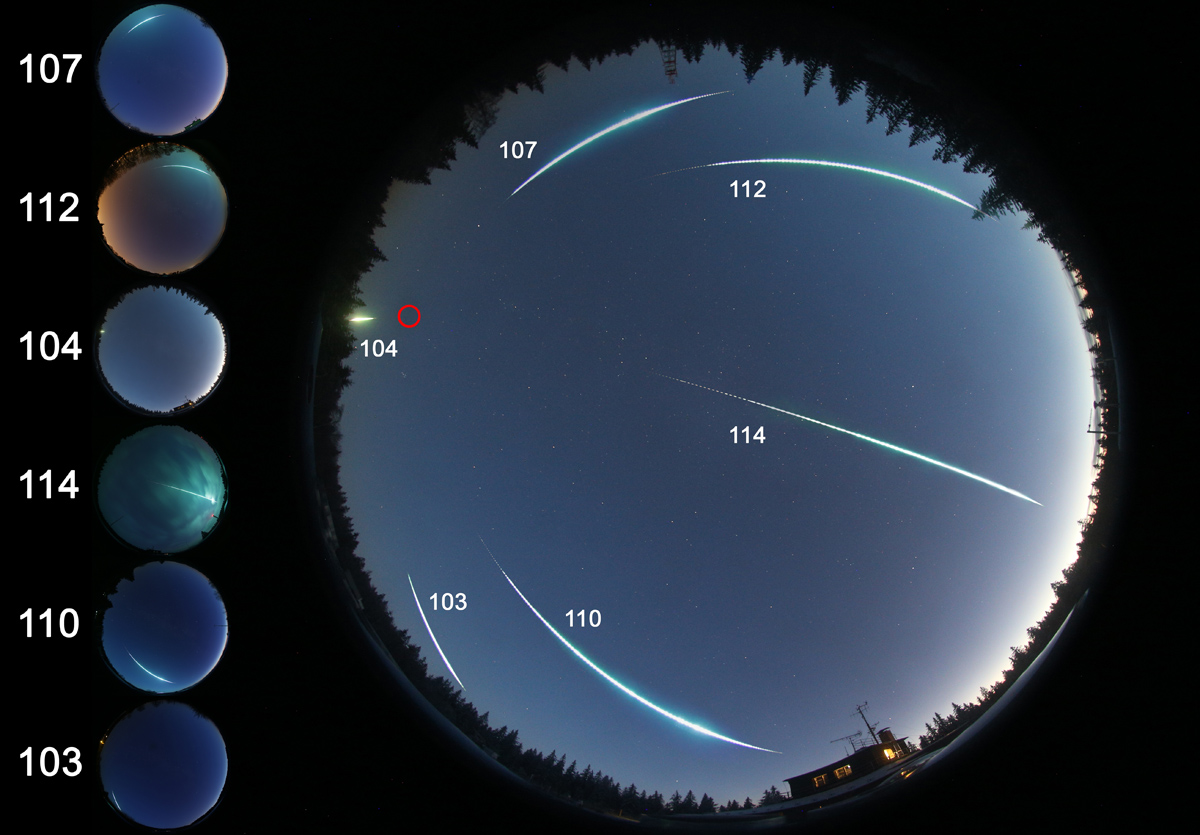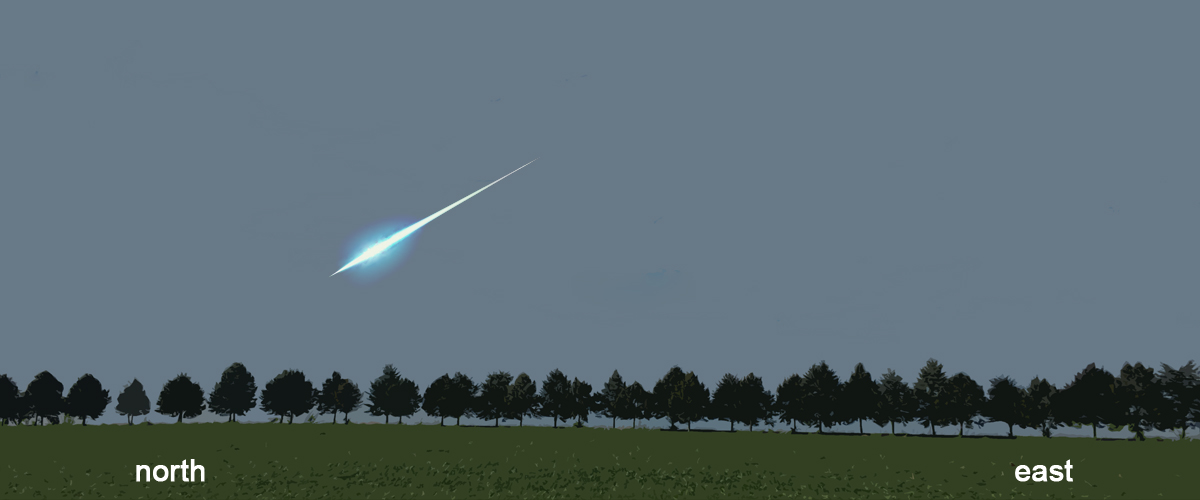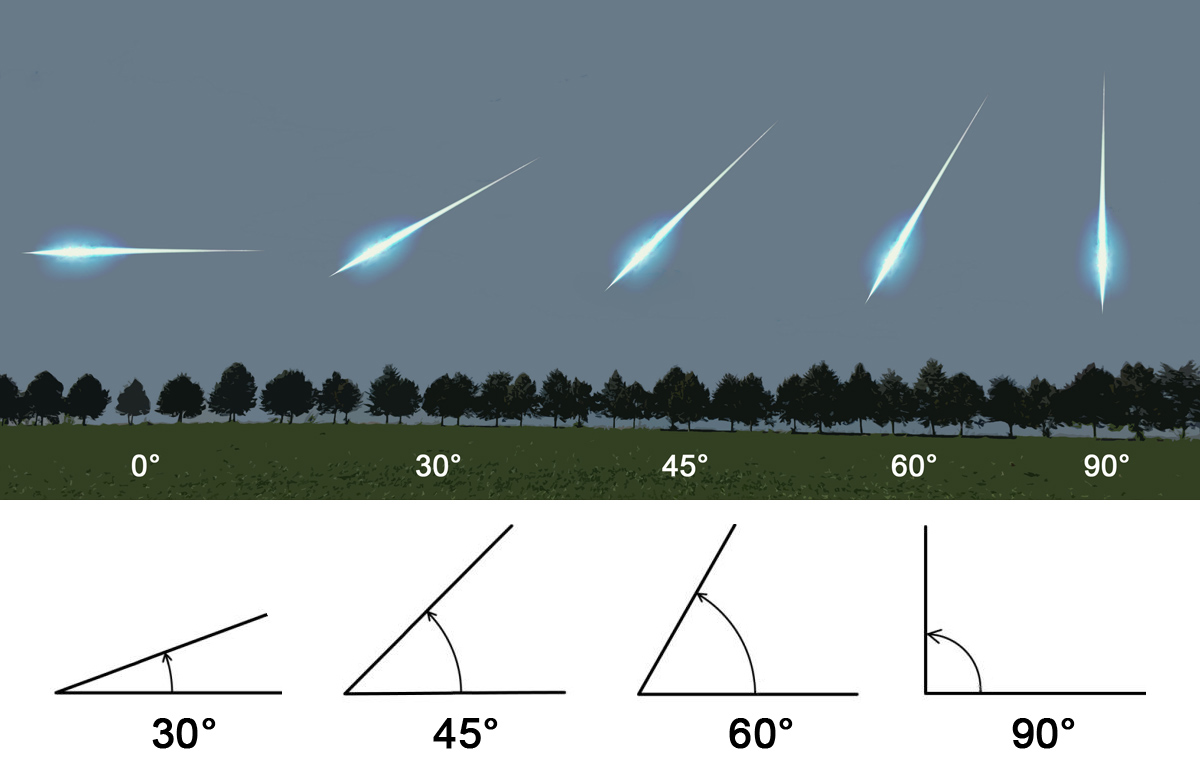How to identify a bolide and how to fill in the bolide report form
If a person sees something unfamiliar or strange in the sky, it does not necessarily mean that it was a flyby of a bright meteor, called a bolide. There are many man-made objects flying in the sky. At night these may be aircraft, space satellites, pyrotechnics or lucky lanterns, but during the day they are mostly aircraft suitably illuminated by the sun. In most cases a simple clue can be used to distinguish a bolide and that is duration. Bolides usually last only units of seconds. Only rarely does the duration of a bolide exceed 10 seconds, which occurs when the geometry of the meteor’s impact with the Earth is such that the meteor is moving towards the surface of the Earth at a very low inclination. In contrast to shorter bolide durations, aircraft or satellites tend to be observable for tens of seconds to units of minutes. In addition, the regular flickering of planes is a phenomenon not observed in bolide events. While sudden brightenings can occur with bolide flares, they are not as regular. Nowadays, people also often observe so-called Starlink satellites, which are groups of several dozen individual satellites flying in a row. Their brightness is very similar to each other, and their distance from each other depends largely on their age in orbit. However, their movement across the sky is very slow and takes several minutes. An example of such a cluster of satellites can be seen, for example, in this video:
So if you observe a point or group of similarly bright points for more than a few tens of seconds, it is probably not a bolide. Meteors also never fly in a zigzag path.
For bolides with a small inclination of the flight path with respect to the surface of the Earth, which can last for a few tens of seconds, there is often significant disintegration of the original body. Thus, several flying fragments can be seen. In most cases, their brightness decreases with distance from the front of the bolide. The reentry of artificial satellites in the Earth’s atmosphere, i.e. their fall from the orbit back to Earth, look very similar. Such phenomena are therefore often not distinguishable at first sight and should be reported.
Bolides are caused by an interplanetary body passing through the Earth’s atmosphere. Due to the mutual geometry and the movements of these bodies in orbits around the Sun, the speed of such bodies in the Earth’s atmosphere is between 11.2 km/s and 72.8 km/s per second. Meteors shine at altitudes of several tens of km above the surface of the Earth, which is why their passage is not directly audible. The internal composition of these bodies differs from each other, which is why the appearance of each meteor is unique. In bolides, we can observe in various forms the disintegration into smaller fragments, a trail visible long after the bolide has passed, an elongated glowing tail behind the front of the bolide, or sudden changes in brightness that can look like explosions. Figure 1 shows an all-sky image of the night sky with six projections of the same bolide as observed and photographed from six different stations of the fireball network in the Czech Republic. The red circle also indicates the radiant, i.e. the point in the sky from which the meteor appears to originate. It can be seen that the closer the meteor is to the radiant, the shorter its path in the sky and therefore the apparent speed at which it moves across the sky.

Bolide reporting is important
Even in today’s age of digital technology, when we have the night sky over our republic covered with a group of cameras aimed at observing flybys of bright meteors, called bolides, it is still useful to get reports of sightings of these rare natural phenomena from casual observers. These reports are most important in the daytime and during dusk or dawn, when our photographic cameras are not observing. Reports during bad weather or the phase of the full moon are also important. But we welcome any fireball report.
You can fill in the bolide report form here:
https://www.asu.cas.cz/cz/verejnost-a-media/hlaseni-bolidu
Date and time of the bolide
Clearly the most important part of any observation is the time of the bolide event. That is why it is listed in the first place of the requested information in our form. The more accurate the time is, the better. This is especially useful in the case of daylight bolides, where the phenomenon needs to be traced on video recordings. Clearly, there is a better chance of tracking the phenomenon on a one minute long video than on an hour long video. This is also why it is necessary to know the accuracy of the bolide time. If the observer looks at a clock immediately after the flyby, nowadays usually on a mobile phone, then he can see the time to the nearest minute. For example, if he sees the time 15:41, it may actually be 15:41:02 or 15:41:58, so the bolide could have flown at the end of the previous and current minute. Then it is a good idea to give the time 15:41 to the nearest 1 minute. To get a more accurate time, either look at the time, which also shows seconds, or take a cell phone photo as soon as possible after the bolide has flown. It doesn’t matter what the picture is taken of, the main thing is that the cell phone will store the time to the second that the picture was taken in the digital image. If that time is, for example, 15:41:33, then we know that the bolide flew a moment before that time. Experience suggests that a person takes a picture no sooner than 10 to 20 seconds after the event. Then it is a good idea to give the time of the bolide as 15:41:13 to the nearest 20 seconds. It is only possible to give the time to the nearest second if one either sees the exact time somewhere during the flight of the bolide or takes a picture or accidentally makes a video recording (with a security camera or a dashboard camera).
If one does not check the time at all, the time is only very indicative to the order of tens of minutes. Then the assignment of such a report to a particular bolide may not even be unambiguous if there are multiple bolides during one night.
Bolide data
The description of the bolide itself will provide further important information. It is useful to provide as detailed a description as possible of what one remembers seeing.
A fireball is a meteor brighter than all the stars and planets in the sky. However, we realize that determining the brightness of an object that usually surprises us is not easy. That is why the estimate of brightness is more of an approximate figure, even if it can be compared to stars, planets or the Moon. The duration of the bolide should be distinguished from the duration of the sighting of the track, which may remain observable in the sky for several minutes after the bolide has passed. It is important to indicate the direction in which the meteor was seen. The cardinal directions can be used, or the direction from the observer to the place where the bolide was seen. Figure 2 shows an example of a meteor with cardinal points. Thus, the bolide was flying between north and east, more precisely over the northeast horizon, even more precisely over the north-northeast. For such a case it is not good to state that the meteor flew from east to west. It is also always a good idea to state whether the meteor flew to the right or to the left, and to try to estimate the slope of its path to the horizon. Figure 3 shows several possible inclinations of the meteor’s path to the horizon. If the meteor flies horizontally, its inclination to the horizon is 0 degrees, if it flies perpendicular to the horizon, its inclination is 90 degrees. So the description of the meteor in Figure 2 would ideally be: “…the meteor flew from the upper right to the lower left over the north-northeast and had an inclination of about 30° to the horizon…”. Another example of a bolide description can be made using Figure 1. An observer at station 114 would have seen the bolide flying perpendicularly down over the western horizon, an observer at station 103 would have seen the meteor flying from the upper left to the lower right at an angle of about 30 degrees over the south-east, and for an observer at station 107 the meteor would have been moving almost horizontally from the right to the left over the north-northeast.
It is more difficult to give the height of the meteor above the horizon. It is also given in degrees ranging from zero (horizon) to 90° (overhead). Usually it is sufficient to distinguish three cases. The first occurs when the meteor is observed so low to the horizon that it is partially obscured by ground objects such as trees or buildings. In this case, the meteor is very far from the observer and often less than 10° above the horizon. The second case corresponds to a situation where the observer notices the meteor in the normal view in front of him/her and therefore there was no need to raise his/her head. This corresponds to a meteor height of approximately 20–30° above the horizon. The third case occurs when one is caught by the bolide high above the horizon and has to raise one’s head to see it. The bolide is thus usually about 45° above the horizon or higher. In this case the observer is relatively close to the bolide.

